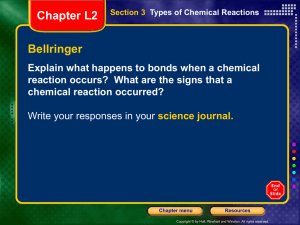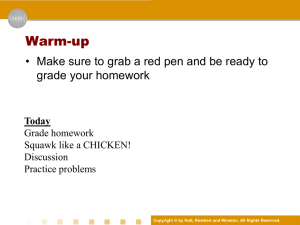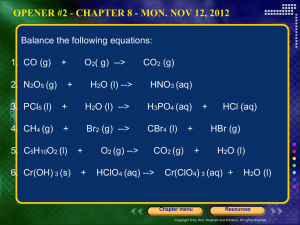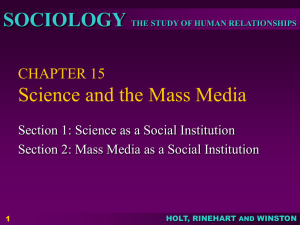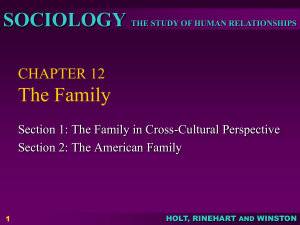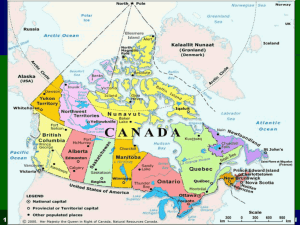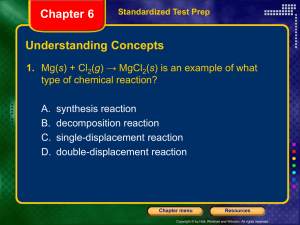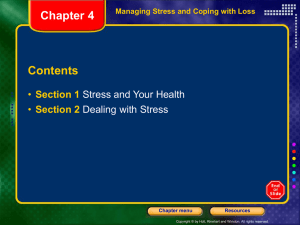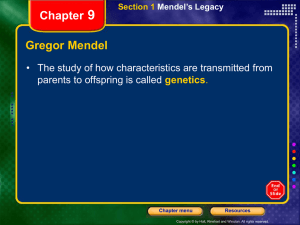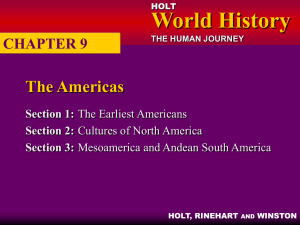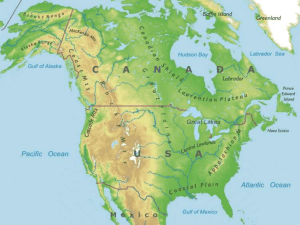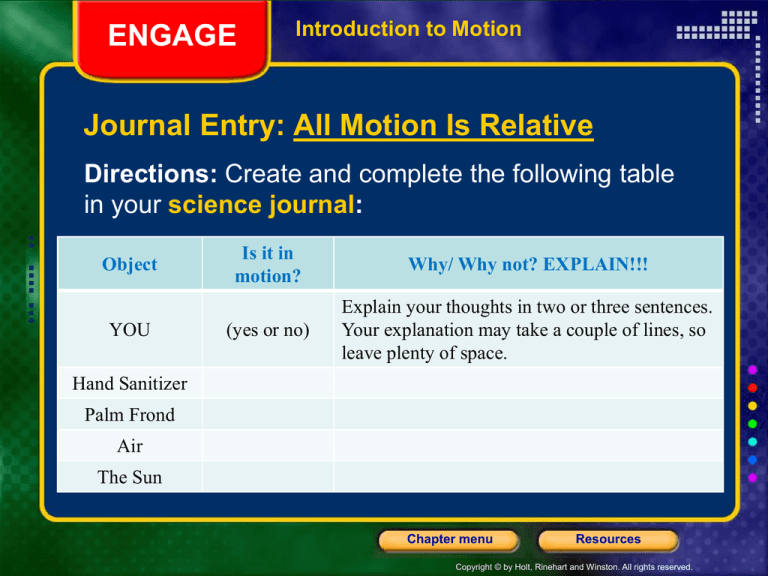
ENGAGE
Introduction to Motion
Journal Entry: All Motion Is Relative
Directions: Create and complete the following table
in your science journal:
Object
YOU
Is it in
motion?
Why/ Why not? EXPLAIN!!!
(yes or no)
Explain your thoughts in two or three sentences.
Your explanation may take a couple of lines, so
leave plenty of space.
Hand Sanitizer
Palm Frond
Air
The Sun
Chapter menu
Resources
Copyright © by Holt, Rinehart and Winston. All rights reserved.
GOALS
Understanding Motion
Mission Objectives
• Know how to accurately describe the position and/or
motion of an object.
• Explain what is meant when we say an object is in
motion.
• Explain the difference between a scalar and a vector.
• Recognize and explain the difference between
distance and displacement.
• Use position, speed, direction of motion, and a
reference point to describe the motion of an object.
Chapter menu
Resources
Copyright © by Holt, Rinehart and Winston. All rights reserved.
Introduction
Understanding Motion
So what IS motion anyway?!?!
• In science, motion is the change of position of an
object relative to a reference point.
• A reference point is an object that appears to stay
in place.
• ANY object can be in motion or NOT in motion,
depending on the reference point (perspective of the
observer).
Chapter menu
Resources
Copyright © by Holt, Rinehart and Winston. All rights reserved.
Input
Understanding Motion
Describing the Position of an Object
• To accurately describe the position of an object, you
must…
1. Establish a reference point. You usually need
three (3) reference points to locate an object in
3 dimensional space!
2. Measure or estimate the distance of the object
from the reference point.
3. Describe the direction of the object’s location
relative to the reference point.
• Example: The moose is 0 cm above the goggles
cabinet, 6 cm east of the west wall, and 30 cm
south of the north wall.
Chapter menu
Resources
Copyright © by Holt, Rinehart and Winston. All rights reserved.
Input
Understanding Motion
Describing the MOTION of an Object
• When you describe the motion of an object, you
should…
1. Establish a reference point.
2. Describe how the object’s distance is changing
relative to the reference point (may include
speed).
3. Describe the direction the object is moving in
relative to the reference point.
Chapter menu
Resources
Copyright © by Holt, Rinehart and Winston. All rights reserved.
RECALL
Understanding Motion
Journal Entry: Understanding Motion
Write a paragraph that explains how you know
when an object is in motion. You may draw
diagrams to help make your explanation clear.
Write your explanation in your science journal.
Chapter menu
Resources
Copyright © by Holt, Rinehart and Winston. All rights reserved.
Understanding Motion: Practice
1. Fill in the Blank: A change in position with respect to a
reference point is called _____________.
2. Describe the position of the digital clock on the
classroom wall.
3. True/False: When standing still in a moving elevator,
you are not moving from the reference point of the
elevator.
If it is false, change the underlined word to make it true!
Explain your answer!!!
4. Describe the motion of a baseball that has just been
pitched as seen from the reference point of home plate.
Chapter menu
Resources
Copyright © by Holt, Rinehart and Winston. All rights reserved.
Describing Motion
• Scalar: A measurement that involves a magnitude.
(Magnitude is an amount or quantity PLUS a unit!)
• Examples: 20 birds, 40 grams, 65 mph, 6 meters.
• Vector: A measurement that involves both a
magnitude and a direction or position.
• Examples: 65 mph NE; backing up 5 feet; 7,600
feet above mean sea level.
Chapter menu
Resources
Copyright © by Holt, Rinehart and Winston. All rights reserved.
Distance Versus Displacement
DISTANCE
•Scalar
•Direction does NOT matter.
•The actual path matters!
•The total distance traveled.
•In the Daytona 500, the cars
travel a distance of 500 miles.
DISPLACEMENT
•Vector
•Direction DOES matter!
•The path does NOT matter!
•The straight-line distance (and
direction) the object has travelled
from its starting point.
•In the Daytona 500, the cars
experience zero displacement
(they start where they end).
Chapter menu
Resources
Copyright © by Holt, Rinehart and Winston. All rights reserved.
REVIEW
Journal Entry: Reviewing Relative Motion
Respond to the following question in your science
journal:
You are sitting still in your seat on a bus that is
traveling 100 km/h on a highway. Is your body at rest
or in motion? Explain your answer! Use a diagram if
it will help make your answer clear.
Chapter menu
Resources
Copyright © by Holt, Rinehart and Winston. All rights reserved.
INPUT
Describing Motion
SPEED
• Speed is the distance traveled divided by the time
taken to travel that distance. It is a scalar quantity!
• Speed is important in describing motion because it
tells how fast an object is moving.
• The units for speed are often m/s, but can be any
distance unit divided by a time unit.
Chapter menu
Resources
Copyright © by Holt, Rinehart and Winston. All rights reserved.
Guided
Practice
Describing Motion
Chapter menu
Resources
Copyright © by Holt, Rinehart and Winston. All rights reserved.
INPUT
Describing Motion
Speed and Velocity: The same… but different!
• Direction of Motion Speed and direction of motion
are combined when describing an object’s velocity.
• Velocity is a quantity that tells both how fast an
object is moving (its speed) and its direction of
motion relative to a reference point.
• Velocity is a vector quantity!
• An object’s velocity may change even if its
speed remains constant (by changing direction).
Chapter menu
Resources
Copyright © by Holt, Rinehart and Winston. All rights reserved.
Check
Understanding
Describing Motion
Draw a Venn Diagram comparing and
contrasting Speed and Velocity
Speed
Velocity
Chapter menu
Resources
Copyright © by Holt, Rinehart and Winston. All rights reserved.
INPUT
Describing Motion
When velocity is a-changin’…
• Sometimes the velocity of an object changes. The
change in velocity over time is called acceleration.
• Acceleration can be a change in speed, a change
in direction, or both.
• The most common units of acceleration are meters
per second per second, which can be abbreviated
m/s/s, but is usually written as m/s2.
Chapter menu
Resources
Copyright © by Holt, Rinehart and Winston. All rights reserved.
Examples
Understanding Motion
Chapter menu
Resources
Copyright © by Holt, Rinehart and Winston. All rights reserved.
PRACTICE
Old Blue Physical Science Textbook:
Page 308 Problems: 2, 4, 5, 19 - 27.
Chapter menu
Resources
Copyright © by Holt, Rinehart and Winston. All rights reserved.

